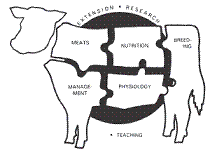Animal Science, Department of

Nebraska Beef Cattle Reports
Date of this Version
2022
Citation
2022 Nebraska Beef Cattle Report
UNL Beef, Institute of Agriculture and Natural Resources, University of Nebraska-Lincoln
Abstract
Six ruminally and duodenally cannulated steers were utilized in a 3 × 3 replicated Latin square experiment to test 0, 15, and 30% dietary inclusion of Green Grass (Sunseo Omega 3; Chungcheong Duk-Do, South Korea), a feed comprised of sesame meal, giant kelp, cassava, and sorghum (not currently approved to be fed in the US). Dry matter and fiber intake increased linearly with increased Green Grass inclusion. Dry matter and organic matter digestibility were not affected by Green Grass inclusion. Concentration of saturated fatty acids at the duodenum were similar for Green Grass 0 and Green Grass 15 with a decrease for Green Grass 30; however, amount of saturated fatty acids increased with increasing Green Grass in the diet. The concentration and flow of unsaturated, mono-unsaturated, poly-unsaturated, and trans fatty acids responded quadratically with the largest increase for Green Grass 30. Omega-3 fatty acid concentration and flow increased linearly from 0 to 30% Green Grass inclusion (1.1 and 11.8 g/d, respectively). Feeding Green Grass increases unsaturated and omega-3 fatty acids flowing to the duodenum, which would be expected to impact fatty acid composition of the beef and may have human nutrition implications.
Included in
Large or Food Animal and Equine Medicine Commons, Meat Science Commons, Veterinary Preventive Medicine, Epidemiology, and Public Health Commons

